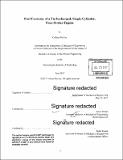| dc.contributor.advisor | Amos Winter. | en_US |
| dc.contributor.author | McCoy, Colleen (Colleen M.) | en_US |
| dc.contributor.other | Massachusetts Institute of Technology. Department of Mechanical Engineering. | en_US |
| dc.date.accessioned | 2017-12-05T19:18:08Z | |
| dc.date.available | 2017-12-05T19:18:08Z | |
| dc.date.copyright | 2017 | en_US |
| dc.date.issued | 2017 | en_US |
| dc.identifier.uri | http://hdl.handle.net/1721.1/112556 | |
| dc.description | Thesis: S.B., Massachusetts Institute of Technology, Department of Mechanical Engineering, 2017. | en_US |
| dc.description | Cataloged from PDF version of thesis. | en_US |
| dc.description | Includes bibliographical references (pages 56-57). | en_US |
| dc.description.abstract | Agriculture is the main source of livelihood for a majority of India's population. However, despite the number of workers, the yield and the yield of principal crops in India is much lower than that in developed nations. One of the reasons for this is the lack of farming mechanization in India. One of the common ways to run farming equipment is by using a single-cylinder, four-stroke diesel engine. Diesel engines can be turbocharged in order to make them more efficient for less cost. A method has been found to turbocharge a single-cylinder diesel engine by adding an air capacitor to form a buffer between the intake and exhaust strokes. This thesis analyzes how the size and heat transfer of the air capacitor for this turbocharged diesel engine are correlated to engine performance and fuel economy. According to the modeled engine, a 3.0 liter capacitor had better peak power and fuel economy at high loads and speeds than a 2.4 or 1.25 liter capacitor. Additionally, forced convection cooling on the capacitor using a fan allowed the intake air density to increase, and the engine to have better fuel economy than the . However the peak power and fuel economy of the modeled naturally aspirated engine was better than the turbocharged engine for speeds below 2500 rpm. The general trends from the model were reflected in the experimental data. The forced convection increased cooling, and improved the intake air density. However, it was difficult to make any confident recommendations about the fuel economy based on the experimental data. | en_US |
| dc.description.statementofresponsibility | by Colleen McCoy. | en_US |
| dc.format.extent | 57 pages | en_US |
| dc.language.iso | eng | en_US |
| dc.publisher | Massachusetts Institute of Technology | en_US |
| dc.rights | MIT theses are protected by copyright. They may be viewed, downloaded, or printed from this source but further reproduction or distribution in any format is prohibited without written permission. | en_US |
| dc.rights.uri | http://dspace.mit.edu/handle/1721.1/7582 | en_US |
| dc.subject | Mechanical Engineering. | en_US |
| dc.title | Fuel economy of a turbocharged, single-cylinder, four-stroke engine | en_US |
| dc.type | Thesis | en_US |
| dc.description.degree | S.B. | en_US |
| dc.contributor.department | Massachusetts Institute of Technology. Department of Mechanical Engineering | |
| dc.identifier.oclc | 1013183724 | en_US |
